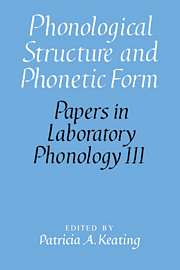Book contents
- Frontmatter
- Contents
- List of contributors
- Acknowledgments
- 1 Introduction
- I Intonation
- II Syllables
- III Feature Theory
- IV Phonetic Output
- 16 Phonetic evidence for sound change in Quebec French
- 17 Polysyllabic words in the YorkTalk synthesis system
- 18 Phonetic arbitrariness and the input problem: comments on Coleman's paper
- 19 Lip aperture and consonant releases
- 20 Change and stability in the contrasts conveyed by consonant releases
- Index of subjects
- Index of names
18 - Phonetic arbitrariness and the input problem: comments on Coleman's paper
Published online by Cambridge University Press: 26 February 2010
- Frontmatter
- Contents
- List of contributors
- Acknowledgments
- 1 Introduction
- I Intonation
- II Syllables
- III Feature Theory
- IV Phonetic Output
- 16 Phonetic evidence for sound change in Quebec French
- 17 Polysyllabic words in the YorkTalk synthesis system
- 18 Phonetic arbitrariness and the input problem: comments on Coleman's paper
- 19 Lip aperture and consonant releases
- 20 Change and stability in the contrasts conveyed by consonant releases
- Index of subjects
- Index of names
Summary
YorkTalk is an impressive accomplishment because it is an explicit implementation of a formal phonological system and its phonetic interpretation; explicit enough to produce speech. John Coleman could very well answer criticism by saying, “that's an interesting idea, does it work?” Undaunted by my own lack of an explicit implementation of anything, I will raise some points of concern, and react to some of the issues brought into focus by the explicitness of YorkTalk.
The YorkTalk synthesis system contains two mappings and three levels of representation. A phonotactic parser constructs hierarchical phonological structures from transcription (using “phoneme-like symbols”). These phonological structures are then used to determine parametric values for a software formant synthesizer. Some general issues arise in connection with (1) the mapping from phonological structure to synthesis parameters as it relates to the arbitrariness of phonetics, and (2) the mapping from transcription to phonological structure as it relates to the input problem in phonological theory.
The arbitrariness of phonetics
In discussing the mapping between phonological structure and synthesis parameter tracks, Coleman points out that because phonological representations and parametric phonetic representations are “very different kinds of objects,” the mapping between them is by necessity arbitrary. The implementation of a phonetics/phonology interface in YorkTalk emphasizes both the one-to-many and the many-to-one nature of the mapping between phonological features and parametric phonetic values.
Concerning the one-to-many nature of the mapping, consider the phonological feature [± voice]. There is a parameter in the Klatt synthesizer called AV (amplitude of voicing), so we might hypothesize that to phonetically implement [– voice] one simply sets the AV to zero.
- Type
- Chapter
- Information
- Phonological Structure and Phonetic Form , pp. 325 - 330Publisher: Cambridge University PressPrint publication year: 1994



